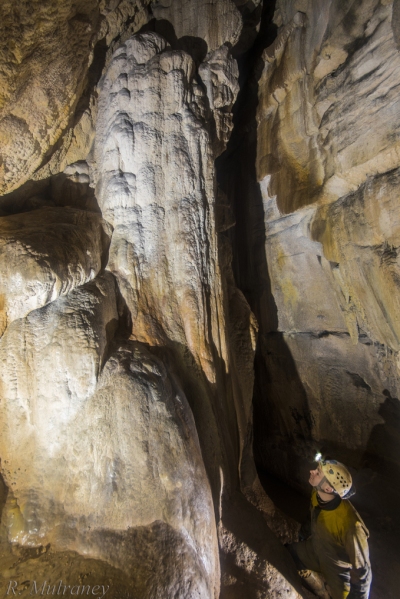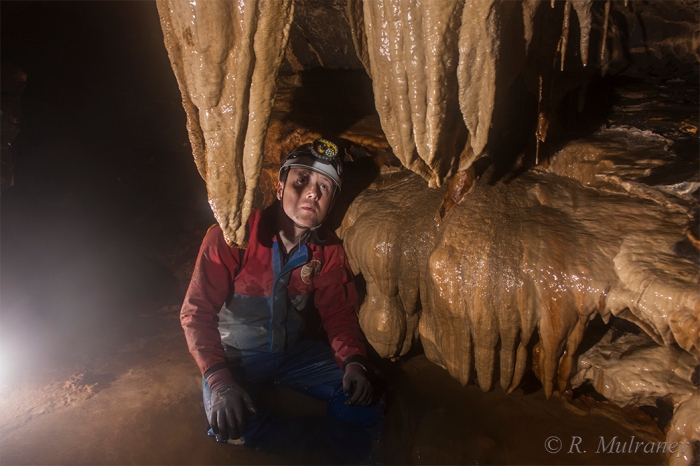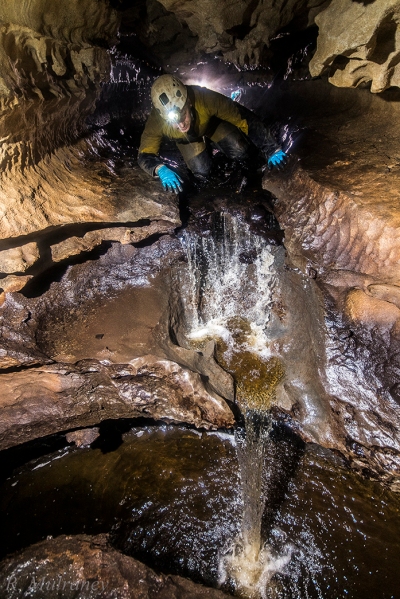County Clare
The Pollnagollum–Poulelva cave system is a large, complex and fascinating stream system which, at 16 km in length, is by far the longest cave in Ireland. I am not currently as familiar with this cave as I would like to be but its enormous size (relative to Irish caves) and the multiplicity of routes that can be undertaken, means that getting acquainted with it is no easy task.
The cave is located in the Burren, the most spectacular landscape in Ireland, I would argue. This enormous area of low rounded hills is special for its surface and sub-surface karst features, including caves, ephemeral turlough lakes, petrifying springs, poljes (water-filled dolines), glacial erratics and limestone pedestals (‘mushroom rocks’), among many more feature types. However, the karst feature which dominates the landscape is the limestone pavement which covers much of the Burren.

Limestone pavement is a result of the denudation of upper, softer, geological layers as well as soil horizons by retreating glaciers. The Burren has the best of limestone pavement in Western Europe while the rest of Europe, I believe, would have serious competition! While it somewhat resembles a desert landscape (“Boíreann” being Irish for “a rocky place”), it is anything but, with the Burren National Park containing 75% of Ireland’s plant species, including many artic-alpine species and almost all of its verities of orchids.

Pollnagollum is located centrally within the Burren and is one of its most significant karst features. It is geologically a very complex cave, the majority of it being stream passages receiving flow from innumerable inlets and through some of the six or so entrances. Created by streams running off the shale-capped peak of Sliabh Elva and dissolving through limestone at the Eastern shale-limestone boundary, this typical cave-forming event occurred at numerous times. At least three such events occurred over timescales prior to the last Ice Age and continuing after glacial retreat. This resulted in parts, such as Upper Pollnagollun, today the section of cave nearest to the water sources, being dated as being younger than the lower-down areas to which it delivers its streams. In other parts, there are ‘misfit’ streams which today flow through passages in which they originally had no input in the creation of. Dramatic surface and subsurface geological changes have seen disparate segments of varying ages join into what is today a master cave of great complexity.

However, in sporting trips to the cave this is not immediately obvious as one walks for kilometres through seemingly endless meandering passages with fine scalloped walls of exceptionally clean and well bedded limestone. There are some fine features to notice, outside of the occasional well decorated passage or grotto, such as the small waterfalls created where the stream makes contact with a chert bed which, not being soluble like limestone, breaks at a sharp dip, causing the water to cascade. There are also many ‘mushrooms’, where a rounded ‘cap’ of undissolved chert protects the limestone ‘stem’ on which it is seated, giving a mushroom shape. The cave also features some impressive high avens and the 35m deep Poulelva Pothole, an entrance into the cave from the surface.
Pollnagollum-Poulelva has a rich history of exploration which began in the late 19th century. Continuing into the 20th century a very large number of British caving societies visited, explored and surveyed parts of the system. It’s exploration and attempts to unravel its history essentially continue to this day and it seems likely that it will remain, justifiably, as one of the country’s most popular caves.




One thought on “Pollnagollum”
Comments are closed.